Reservoir Characteristics and Influencing Factors of Organic-Rich Siliceous Shale of the Upper Permian Dalong Formation in Western Hubei
Abstract
1. Introduction
2. Geological Setting
3. Samples and Experiments
3.1. Sampling
3.2. XRD and Organic Geochemistry
3.3. Scanning Electron Microscope (SEM)
3.4. Total Porosity and CO2 and N2 Adsorption Experiments
4. Results
4.1. Mineral Compositions and Lithofacies Classification
4.2. Organic Geochemistry Characters
4.2.1. Organic Matter Content
4.2.2. Organic Matter Maturity and Types
4.3. Porosity
4.4. Pore Types
4.4.1. Organic Matter Pores
4.4.2. Inorganic Matter Pores
4.4.3. Microfractures
4.5. Quantitative Analyses of Pore Structure
5. Discussion
5.1. Relationships between Pore Structure Parameters and Organic Matter
5.2. Relationships between Pore Structure Parameters and Mineral Composition
5.3. Control Factors of Pore Development in the Dalong Formation’s Siliceous Shale
6. Conclusions
Author Contributions
Funding
Data Availability Statement
Acknowledgments
Conflicts of Interest
References
- Xu, J.; Wu, K.; Li, R.; Li, Z.; Li, J.; Xu, Q.; Chen, Z. Real gas transport in shale matrix with fractal structures. Fuel 2018, 219, 353–363. [Google Scholar] [CrossRef]
- Xu, J.; Wu, K.; Yang, S.; Cao, J.; Chen, Z.; Pan, Y.; Yan, B. Real gas transport in tapered noncircular nanopores of shale rocks. AIChE J. 2017, 63, 3224–3242. [Google Scholar] [CrossRef]
- Xu, J.; Wu, K.; Li, R.; Li, Z.; Li, J.; Xu, Q.; Li, L.; Chen, Z. Nanoscale pore size distribution effects on gas production from fractal shale rocks. Fractals 2019, 27, 1950142. [Google Scholar] [CrossRef]
- Hao, F.; Zou, H.Y.; Lu, Y.C. Mechanisms of shale gas storage: Implications for shale gas exploration in China. AAPG Bull. 2013, 97, 1325–1346. [Google Scholar] [CrossRef]
- Ma, Y.; Cai, X.; Zhao, P. China’s shale gas exploration and development: Understanding and practice. Pet. Explor. Dev. 2018, 45, 589–603. [Google Scholar] [CrossRef]
- Fan, C.; Li, H.; Qin, Q.; He, S.; Zhong, C. Geological conditions and exploration potential of shale gas reservoir in Wufeng and Longmaxi Formation of southeastern Sichuan Basin, China. J. Pet. Sci. Eng. 2020, 191, 107138. [Google Scholar] [CrossRef]
- Guo, T.; Zhang, H. Formation and enrichment mode of Jiaoshiba shale gas field, Sichuan Basin. Pet. Explor. Dev. 2014, 41, 28–36. [Google Scholar] [CrossRef]
- Liu, W.; Yao, J.; Tong, J.; Qiao, Y.; Chen, Y. Organic matter accumulation on the Dalong Formation (Upper Permian) in Western Hubei, South China: Constraints from multiple geochemical proxies and pyrite morphology. Palaeogeogr. Palaeoclimatol. Paleoecol. 2019, 514, 677–689. [Google Scholar] [CrossRef]
- Wu, W.; Liu, W.; Mou, C.; Liu, H.; Qiao, Y.; Pan, J.; Ning, S.; Zhang, X.; Yao, J.; Liu, J. Organic-rich siliceous rocks in the upper Permian Dalong Formation (NW middle Yangtze): Provenance, paleoclimate and paleoenvironment. Mar. Pet. Geol. 2021, 123, 104728. [Google Scholar] [CrossRef]
- Zhuo, J.W.; Wang, J.; Wang, Z.J.; Xie, Y.; Yang, P.; Liu, J.Q. Sedimentary characteristics of late Permian in western Hubei province and evolution of inter-platform rift. Xinjing Pet. Geol. 2009, 30, 300–303. [Google Scholar]
- Zheng, B.S.; Mou, C.L.; Wang, X.P.; Chen, H.D.; Xiao, Z.H. Paleoclimate and paleoceanographic evolution during the Permian-Triassic transition (western Hubei area, South China) and their geological implications. Palaeogeogr. Palaeoclimatol. Paleoecol. 2021, 564, 110166. [Google Scholar] [CrossRef]
- Meng, F.Y.; Chen, K.; Bao, S.J.; Lin, T.; Zhang, R.; Dong, Z.B. Determination of marine-continental transitional facies shale gas:A case study of Baye No. 1 well in Badong area, western Hubei Province. Geol. China 2017, 44, 403–404. [Google Scholar]
- Xie, T.; Pan, S.Y.; Wang, Y.; Ren, Z.J.; Yu, J.H.; Duan, K. Analysis on main controlling factors of shale gas enrichment in Upper Permian Dalong Formation in Well Endi 1, Western Hubei. Resour. Environ. Eng. 2022, 36, 149–153. [Google Scholar] [CrossRef]
- Dong, T.; He, S.; Chen, M.; Hou, Y.; Guo, X.; Wei, C.; Han, Y.; Yang, R. Quartz types and origins in the paleozoic Wufeng-Longmaxi Formations, Eastern Sichuan Basin, China: Implications for porosity preservation in shale reservoirs. Mar. Pet. Geol. 2019, 106, 62–73. [Google Scholar] [CrossRef]
- Gou, Q.; Xu, S.; Hao, F.; Zhang, B.; Shu, Z.; Yang, F.; Wang, Y.; Li, Q. Quantitative calculated shale gas contents with different lithofacies: A case study of Fuling gas shale, Sichuan Basin, China. J. Nat. Gas Sci. Eng. 2020, 76, 103222. [Google Scholar] [CrossRef]
- Gou, Q.; Xu, S.; Hao, F.; Yang, F.; Zhang, B.; Shu, Z.; Zhang, A.; Wang, Y.; Lu, Y.; Cheng, X.; et al. Full-scale pores and micro-fractures characterization using FE-SEM, gas adsorption, nano-CT and micro-CT: A case study of the Silurian Longmaxi Formation shale in the Fuling area, Sichuan Basin, China. Fuel 2019, 253, 167–179. [Google Scholar] [CrossRef]
- Xu, S.; Gou, Q.Y.; Hao, F.; Zhang, B.Q.; Shu, Z.G.; Lu, Y.B.; Wang, Y.X. Shale pore structure characteristics of the high and low productivity wells, Jiaoshiba shale gas field, Sichuan Basin, China: Dominated by lithofacies or preservation condition? Mar. Pet. Geol. 2020, 114, 104211. [Google Scholar] [CrossRef]
- Xu, S.; Hao, F.; Shu, Z.; Zhang, A.; Yang, F. Pore structures of different types of shales and shale gas exploration of the Ordovician Wufeng and Silurian Longmaxi successions in the eastern Sichuan Basin, South China. J. Asian Earth Sci. 2020, 193, 104271. [Google Scholar] [CrossRef]
- Han, C.; Jiang, Z.; Han, M.; Wu, M.; Lin, W. The lithofacies and reservoir characteristics of the Upper Ordovician and Lower Silurian black shale in the Southern Sichuan Basin and its periphery, China. Mar. Pet. Geol. 2016, 75, 181–191. [Google Scholar] [CrossRef]
- Cao, T.; Song, Z.; Wang, S.; Cao, X.; Li, Y.; Xia, J. Characterizing the pore structure in the Silurian and Permian shales of the Sichuan Basin, China. Mar. Pet. Geol. 2015, 61, 140–150. [Google Scholar] [CrossRef]
- Yang, R.; He, S.; Yi, J.; Hu, Q. Nano-scale pore structure and fractal dimension of organic-rich Wufeng-Longmaxi shale from Jiaoshiba area, Sichuan Basin: Investigations using FE-SEM, gas adsorption and helium pycnometry. Mar. Pet. Geol. 2016, 70, 27–45. [Google Scholar] [CrossRef]
- Yin, H.; Jiang, H.; Xia, W.; Feng, Q.; Zhang, N.; Shen, J. The end-Permian regression in South China and its implication on mass extinction. Earth-Sci. Rev. 2013, 137, 19–33. [Google Scholar] [CrossRef]
- Bai, L.H.; Shi, W.Z.; Zhang, X.M.; Xu, X.F.; Liu, Y.Z.; Yang, Y.; Feng, Q.; Cao, S.T. Characteristics of Permian Marine Shale and Its Sedimentary Environment in Xuanjing Area, South Anhui Province, Lower Yangtze Area. Earth Sci. 2021, 46, 2204–2217. [Google Scholar]
- Wu, Z.; He, S.; He, Z.; Li, X.; Zhai, G.; Huang, Z. Petrographical and geochemical characterization of the Upper Permian Longtan formation and Dalong Formation in the Lower Yangtze region, South China: Implications for provenance, paleoclimate, paleoenvironment and organic matter accumulation mechanisms. Mar. Pet. Geol. 2022, 139, 105580. [Google Scholar] [CrossRef]
- Lei, L.-D.; Shen, J.; Li, C.; Algeo, T.J.; Chen, Z.-Q.; Feng, Q.-L.; Cheng, M.; Jin, C.-S.; Huang, J.-H. Controls on regional marine redox evolution during Permian-Triassic transition in South China. Palaeogeogr. Palaeoclim. Palaeoecol. 2017, 486, 17–32. [Google Scholar] [CrossRef]
- Xu, L.L.; Wen, Y.R.; Zhang, Y.L.; Ren, Z.J.; Yang, J.; Wen, J.H.; Chen, W.; Luo, F.; Duan, K. Gas-bearing characteristics and preservation conditions of Upper Ordovician Wufeng-Lower Silurian Longmaxi shale in western Hubei. Pet. Geol. Exp. 2021, 43, 395–406. [Google Scholar] [CrossRef]
- SY/T5163-2018; Analysis Method for Clay Minerals and Ordinary Non-Clay Minerals in Sedimentary Rocks by the X-ray diffraction. National Energy Administration: Beijing, China, 2018.
- GB/T19145-2003; Determination of Total Organic Carbon in Sedimentary Rock. General Administration of Quality Supervision, Inspection and Quarantine of the People’s Republic of China: Beijing, China, 2003.
- SY/T5124-2012; Method of Determining Microscopically the Reflectance of Vitrinite in Sedimentary. National Energy Administration: Beijing, China, 2012.
- SY/T5125-1996; Identification and Classification of Maceral Components of Kerogen by Transmitting Light and Fluorescence. National Energy Administration: Beijing, China, 1996.
- Wu, L.; Hu, D.; Lu, Y.; Liu, R.; Liu, X. Advantageous shale lithofacies of Wufeng Formation-Longmaxi Formation in Fuling gas field of Sichuan Basin, SW China. Pet. Explor. Dev. 2016, 43, 208–217. [Google Scholar] [CrossRef]
- Wu, L.; Lu, Y.; Jiang, S.; Lu, Y.; Liu, X.; Hu, H. Pore structure characterization of different lithofacies in marine shale: A case study of the Upper Ordovician Wufeng-Lower Silurian Longmaxi formation in the Sichuan Basin, SW China. J. Nat. Gas Sci. Eng. 2018, 57, 203–215. [Google Scholar] [CrossRef]
- Ma, Y.; Lu, Y.; Liu, X.; Zhai, G.; Wang, Y.; Zhang, C. Depositional environment and organic matter enrichment of the lower Cambrian Niutitang shale in western Hubei Province, South China. Mar. Pet. Geol. 2019, 109, 381–393. [Google Scholar] [CrossRef]
- Gou, Q.; Xu, S.; Hao, F.; Lu, Y.; Shu, Z.; Wang, Z.; Wang, Y. Evaluation of the exploration prospect and risk of marine gas shale, southern China: A case study of Wufeng-Longmaxi shales in the Jiaoshiba area and Niutitang shales in the Cen’gong area. GSA Bull. 2022, 134, 1585–1602. [Google Scholar] [CrossRef]
- Qin, Y.L.; Lei, Y.; Jiang, S.; Zhang, R.; Zhang, L.C.; Cen, W.P.; Lu, B.X. Shale gas accumulation conditions and resource potential evaluation of member 1 of the Lower Carboniferous Luzhai Formation in the northern Guizhong depression. Pet. Sci. Bull. 2022, 2, 139–154. [Google Scholar] [CrossRef]
- Vandenbroucke, M.; Largeau, C. Kerogen origin, evolution and structure. Org. Geochem. 2007, 38, 719–833. [Google Scholar] [CrossRef]
- Liu, B.; Mastalerz, M.; Schieber, J.; Teng, J. Association of uranium with macerals in marine black shales: Insights from the Upper Devonian New Albany Shale, Illinois Basin. Int. J. Coal Geol. 2019, 217, 103351. [Google Scholar] [CrossRef]
- Loucks, R.G.; Reed, R.M.; Ruppel, S.C.; Jarvie, D.M. Morphology, Genesis, and Distribution of Nanometer-Scale Pores in Siliceous Mudstones of the Mississippian Barnett Shale. J. Sediment. Res. 2009, 79, 848–861. [Google Scholar] [CrossRef]
- Loucks, R.G.; Reed, R.M.; Ruppel, S.C.; Hammes, U. Spectrum of pore types and networks in mudrocks and a descriptive classification for matrix-related mudrock pores. AAPG Bull. 2012, 96, 1071–1098. [Google Scholar] [CrossRef]
- Slatt, R.M.; O’Brien, N.R. Pore types in the Barnett and Woodford gas shales: Contribution to understanding gas storage and migration pathways in fine-grained rocks. AAPG Bull. 2011, 95, 2017–2030. [Google Scholar] [CrossRef]
- Liu, B.; Schieber, J.; Mastalerz, M. Combined SEM and reflected light petrography of organic matter in the New Albany Shale (Devonian-Mississippian) in the Illinois Basin: A perspective on organic pore development with thermal maturation. Int. J. Coal Geol. 2017, 184, 57–72. [Google Scholar] [CrossRef]
- Liu, B.; Teng, J.; Mastalerz, M.; Schieber, J.; Schimmelmann, A.; Bish, D. Compositional Control on Shale Pore Structure Characteristics across a Maturation Gradient: Insights from the Devonian New Albany Shale and Marcellus Shale in the Eastern United States. Energy Fuels 2021, 35, 7913–7929. [Google Scholar] [CrossRef]
- Singh, S.B.; De, M. Alumina based doped templated carbons: A comparative study with zeolite and silica gel templates. Microporous Mesoporous Mater. 2018, 257, 241–252. [Google Scholar] [CrossRef]
- Singh, S.B.; De, M. Thermally exfoliated graphene oxide for hydrogen storage. Mater. Chem. Phys. 2019, 239, 122102. [Google Scholar] [CrossRef]
- Mastalerz, M.; Drobniak, A.; Stankiewicz, A.B. Origin, properties, and implications of solid bitumen in source-rock reservoirs: A review. Int. J. Coal Geol. 2018, 195, 14–36. [Google Scholar] [CrossRef]
- Liu, B.; Mastalerz, M.; Schieber, J. SEM petrography of dispersed organic matter in black shales: A review. Earth-Science Rev. 2022, 224, 103874. [Google Scholar] [CrossRef]
- Boström, K.; Kraemer, T.; Gartner, S. Provenance and accumulation rates of opaline silica, Al, Ti, Fe, Mn, Cu, Ni and Co in Pacific pelagic sediments. Chem. Geol. 1973, 11, 123–148. [Google Scholar] [CrossRef]
- Wedepohl, K.H. Environmental influences on the chemical composition of shales and clays. J. Phys. Chem. 1971, 8, 305–333. [Google Scholar] [CrossRef]
- Ross, D.J.K.; Bustin, R.M. Investigating the use of sedimentary geochemical proxies for paleoenvironment interpretation of thermally mature organic-rich strata: Examples from the Devonian-Mississippian shales, Western Canadian Sedimentary Basin. Chem. Geol. 2009, 260, 1–19. [Google Scholar] [CrossRef]
- Hong, H.; Zhao, L.; Fang, Q.; Algeo, T.J.; Wang, C.; Yu, J.; Gong, N.; Yin, K.; Ji, K. Volcanic sources and diagenetic alteration of Permian–Triassic boundary K-bentonites in Guizhou Province, South China. Palaeogeogr. Palaeoclim. Palaeoecol. 2019, 519, 141–153. [Google Scholar] [CrossRef]
- Zheng, B.; Mou, C.; Wang, X.; Xiao, Z.; Chen, Y. Sedimentary record of the collision of the North and South China cratons: New insights from the Western Hubei Trough. Geol. J. 2018, 54, 3335–3348. [Google Scholar] [CrossRef]
- Xie, W.; Wang, M.; Wang, H.; Ma, R.; Duan, H. Diagenesis of shale and its control on pore structure, a case study from typical marine, transitional and continental shales. Front. Earth Sci. 2021, 15, 378–394. [Google Scholar] [CrossRef]
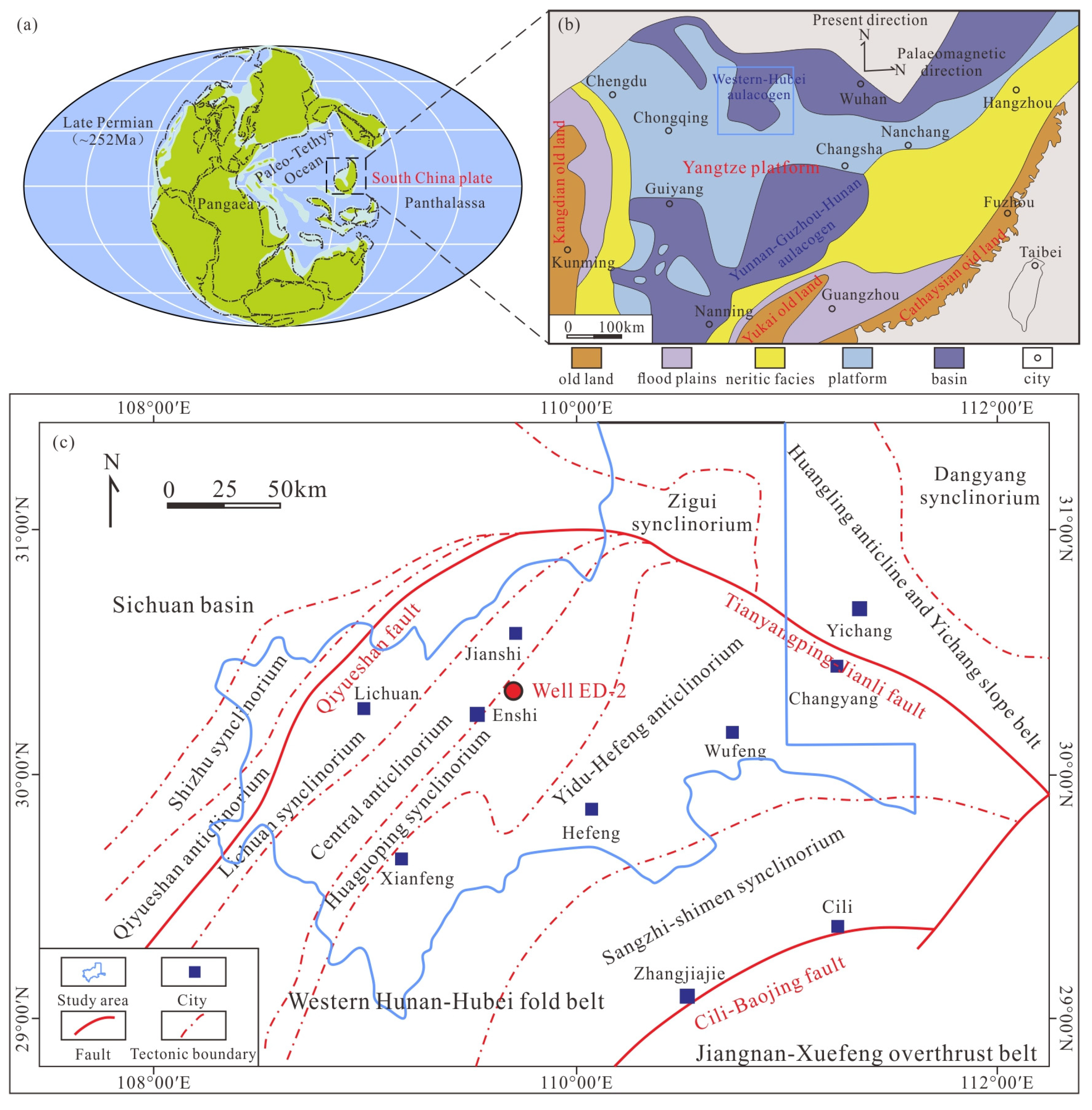
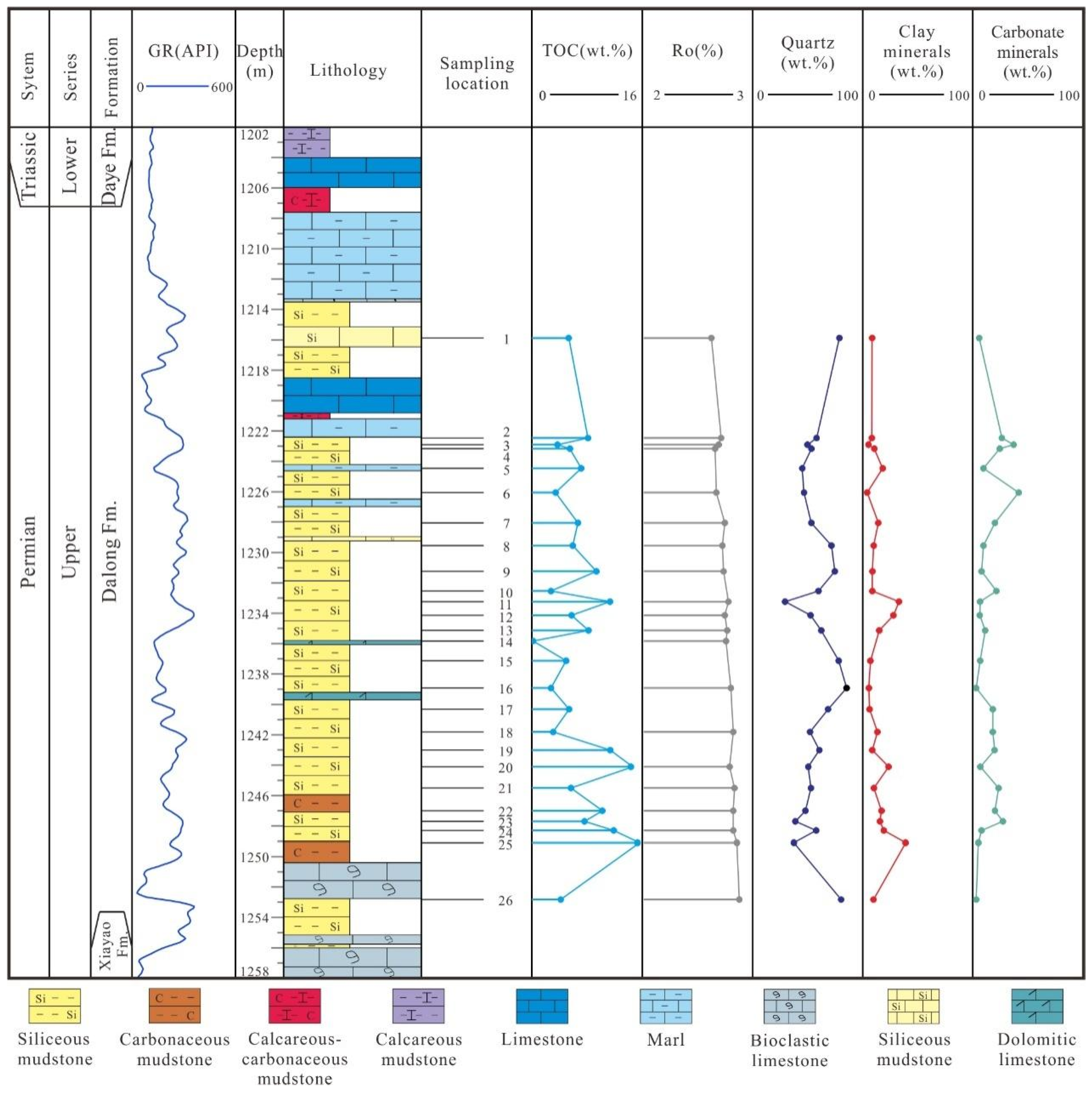
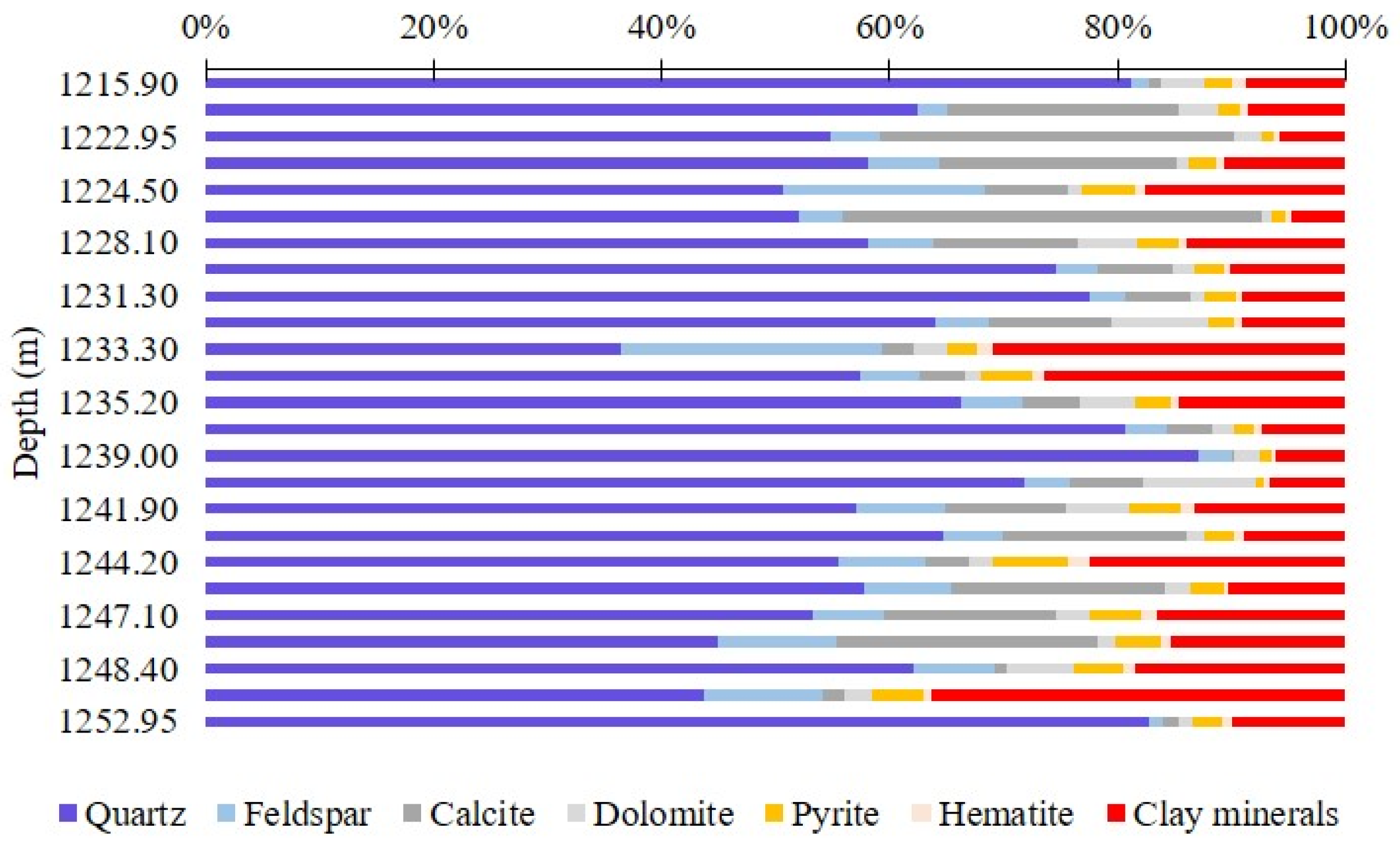

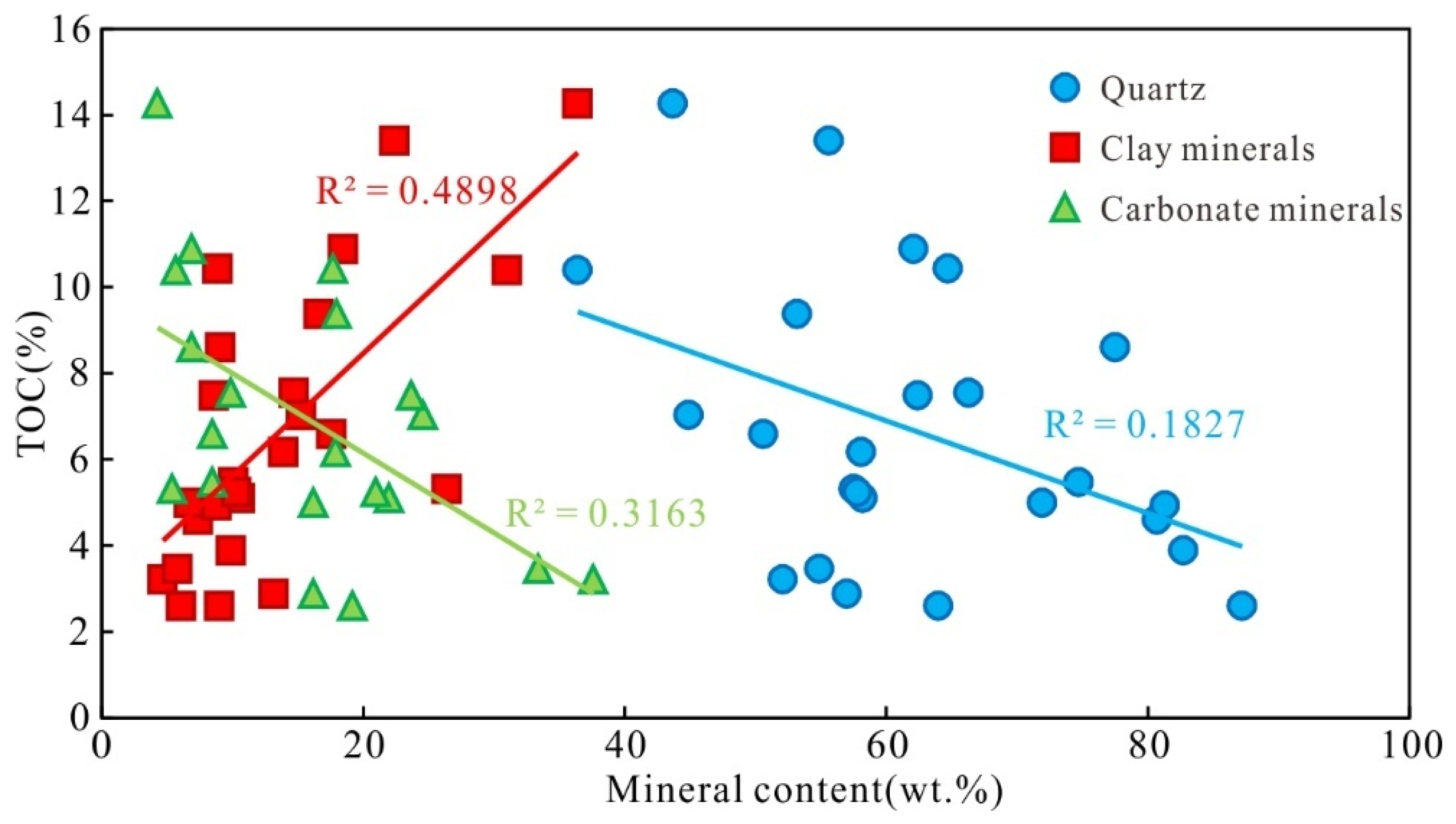



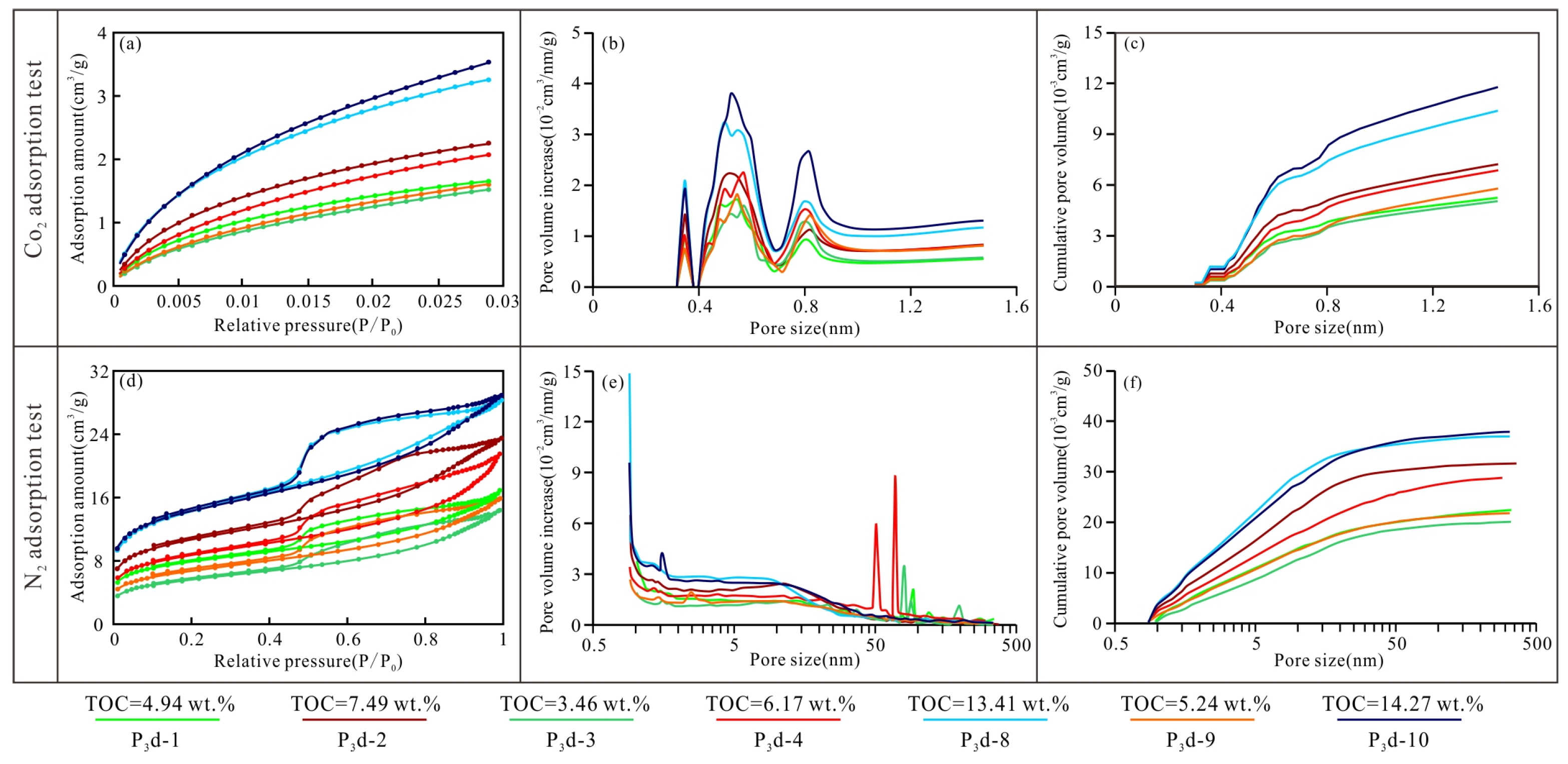


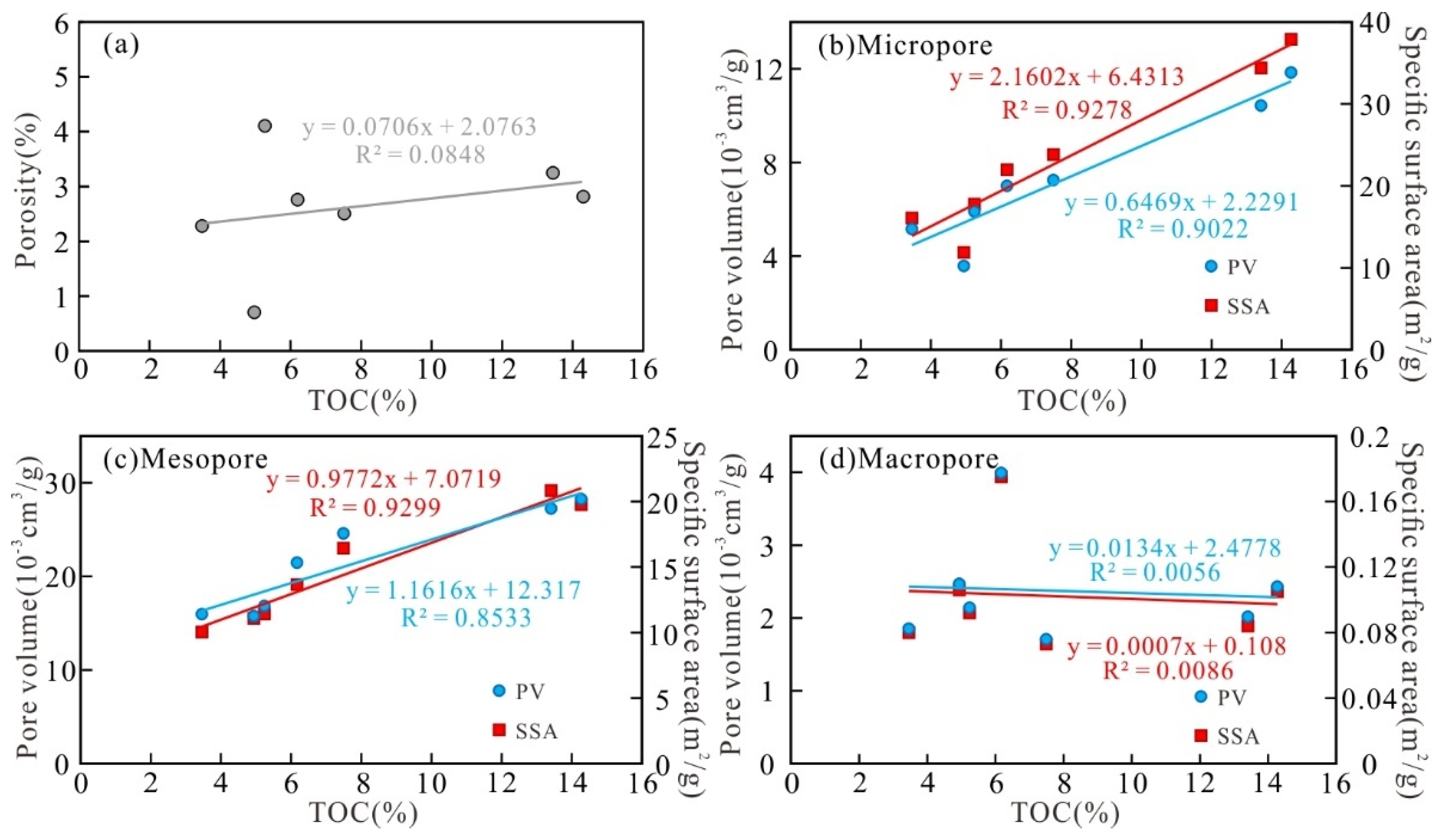
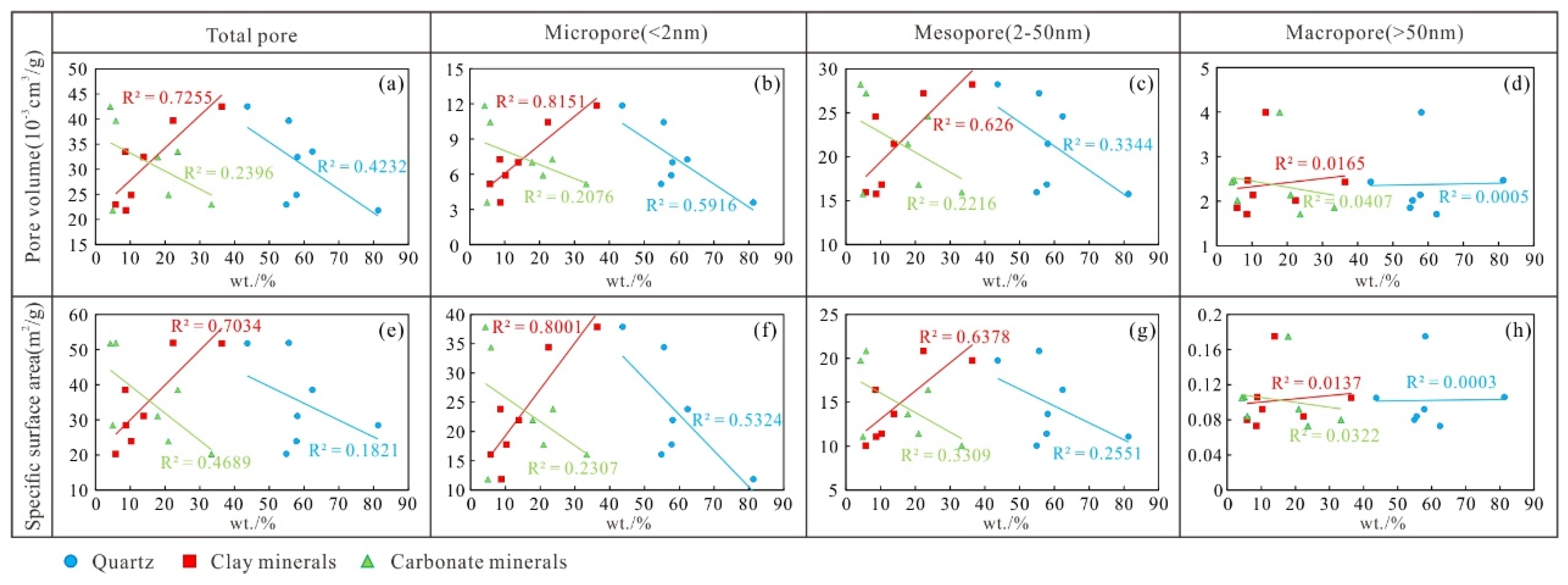
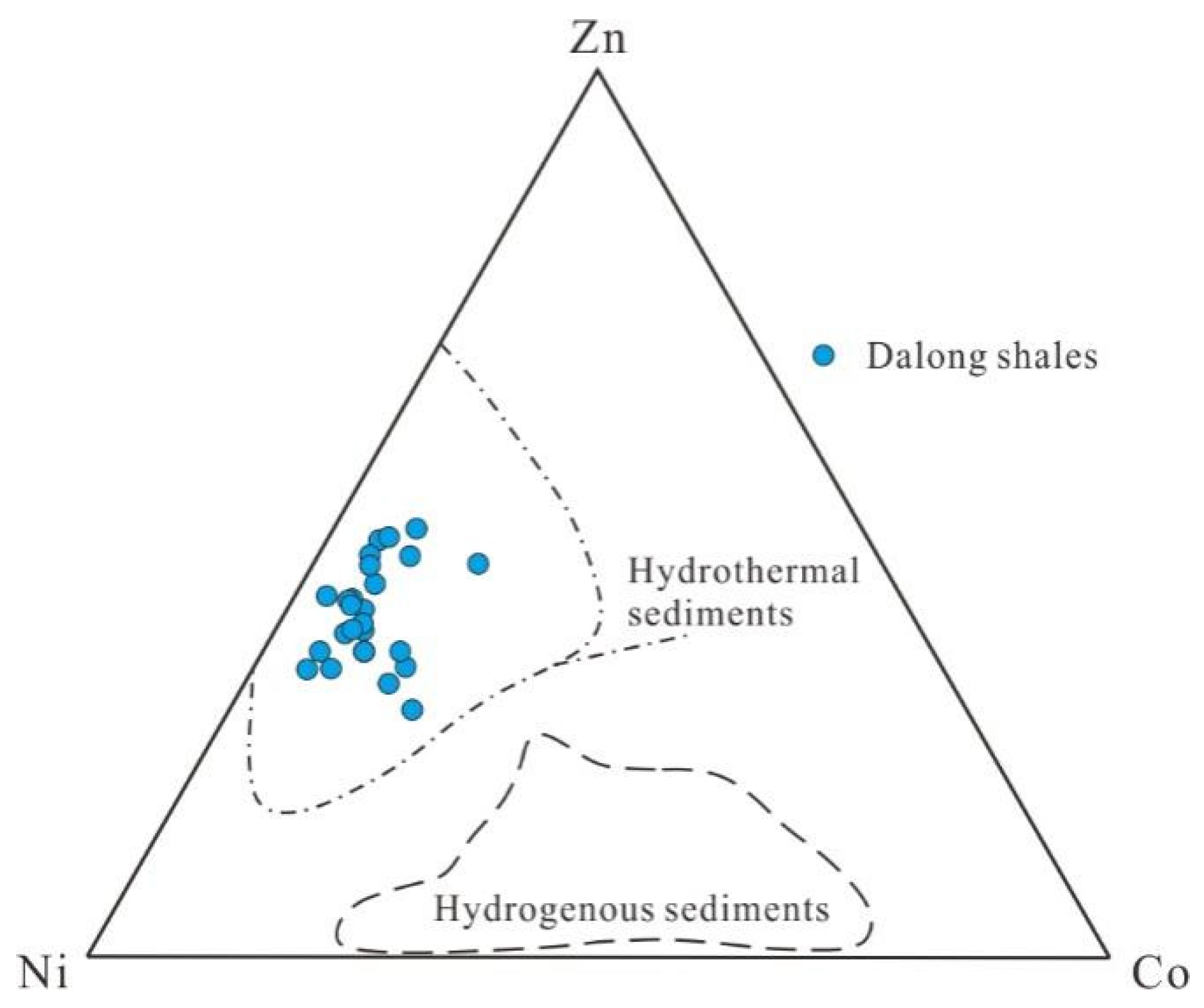

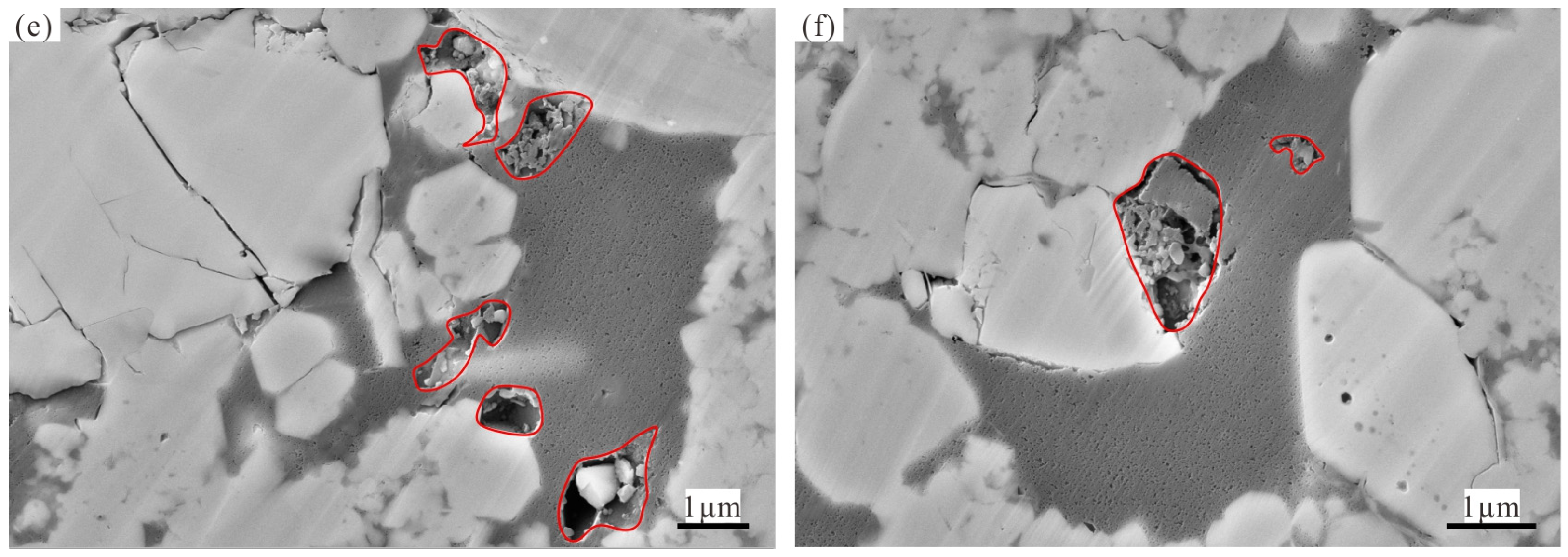
| Sample Location | Strata | Depth (m) | TOC (wt.%) | Ro (%) | Mineral Content (wt.%) | ||
|---|---|---|---|---|---|---|---|
| Quartz | Clay | Carbonate | |||||
| Niutitang Formation in western Hubei [34] | Lower Cambrian | 3000 | 2.05 | 3.04 | 37.7 | 23.5 | 28.3 |
| Longmaxi Formation in eastern Sichuan [34] | Lower Silurian | 2394 | 305 | 2.91 | 43.7 | 35.7 | 9.1 |
| Luzhai Formation in central Guangxi [35] | Lower Carboniferous | 1600 | 1.86 | 2.67 | 43.0 | 30.0 | 21.1 |
| Dalong Formation in western Hubei | Upper Permian | 1233 | 6.7 | 2.68 | 62..2 | 13.7 | 13.8 |
| Sample No. | Depth (m) | TOC (wt.%) | Ro (%) | Kerogen Type | Mineral Content (wt.%) | ||||
|---|---|---|---|---|---|---|---|---|---|
| Quartz | Feldspar | Clay | Carbonate | Pyrite | |||||
| P3d-1 | 1215.9 | 4.94 | 2.56 | I | 81.3 | 1.4 | 8.8 | 5.0 | 2.4 |
| P3d-2 | 1222.5 | 7.49 | 2.64 | I | 62.4 | 2.7 | 8.6 | 23.7 | 2.0 |
| P3d-3 | 1222.9 | 3.46 | 2.62 | I | 54.9 | 4.3 | 5.8 | 33.4 | 1.1 |
| P3d-4 | 1228.1 | 6.17 | 2.67 | I | 58.1 | 5.8 | 13.9 | 17.9 | 3.6 |
| P3d-5 | 1229.6 | 5.48 | 2.65 | I | 74.7 | 3.6 | 10.1 | 8.5 | 2.5 |
| P3d-6 | 1234..2 | 5.32 | 2.67 | I | 57.5 | 5.2 | 26.4 | 5.4 | 4.4 |
| P3d-7 | 1237.2 | 4.60 | 2.69 | I | 80.7 | 3.7 | 7.4 | 5.8 | 1.7 |
| P3d-8 | 1244.2 | 13.41 | 2.71 | I | 55.6 | 7.5 | 22.4 | 5.9 | 6.6 |
| P3d-9 | 1245.6 | 5.24 | 2.75 | I | 57.8 | 7.6 | 10.6 | 21.0 | 2.9 |
| P3d-10 | 1249.2 | 14.27 | 2.77 | I | 43.7 | 10.5 | 36.4 | 4.3 | 4.4 |
| P3d-11 | 1252.9 | 3.89 | 2.79 | II1 | 82.7 | 1.3 | 9.9 | 2.6 | 2.6 |
| Sample No. | Depth (m) | Average Pore Size (nm) | Pore Volume (10−3 cm3/g) | Specific Surface Area (m2/g) | ||||
|---|---|---|---|---|---|---|---|---|
| Micropore | Mesopore | Macropore | Micropore | Mesopore | Macropore | |||
| P3d-1 | 1215.9 | 3.697 | 3.58 | 15.76 | 2.47 | 11.873 | 11.085 | 0.106 |
| P3d-2 | 1222.5 | 3.787 | 7.25 | 14.59 | 1.71 | 23.827 | 16.426 | 0.073 |
| P3d-3 | 1222.9 | 4.441 | 5.16 | 15.95 | 1.85 | 16.063 | 10.050 | 0.080 |
| P3d-4 | 1228.1 | 4.306 | 7.00 | 21.46 | 3.99 | 21.973 | 13.663 | 0.175 |
| P3d-8 | 1244.2 | 3.354 | 10.43 | 27.24 | 2.02 | 34.395 | 20.828 | 0.084 |
| P3d-9 | 1245.6 | 4.148 | 5.91 | 16.84 | 2.14 | 17.770 | 11.422 | 0.092 |
| P3d-10 | 1249.2 | 3.495 | 11.85 | 28.24 | 2.43 | 37.888 | 19.755 | 0.105 |
Disclaimer/Publisher’s Note: The statements, opinions and data contained in all publications are solely those of the individual author(s) and contributor(s) and not of MDPI and/or the editor(s). MDPI and/or the editor(s) disclaim responsibility for any injury to people or property resulting from any ideas, methods, instructions or products referred to in the content. |
© 2023 by the authors. Licensee MDPI, Basel, Switzerland. This article is an open access article distributed under the terms and conditions of the Creative Commons Attribution (CC BY) license (https://creativecommons.org/licenses/by/4.0/).
Share and Cite
Wang, Y.; Bai, L.; Zhang, Y.; Zhang, X.; Yang, B.; Duan, K.; Wang, Y.; Xie, T. Reservoir Characteristics and Influencing Factors of Organic-Rich Siliceous Shale of the Upper Permian Dalong Formation in Western Hubei. Energies 2023, 16, 5130. https://doi.org/10.3390/en16135130
Wang Y, Bai L, Zhang Y, Zhang X, Yang B, Duan K, Wang Y, Xie T. Reservoir Characteristics and Influencing Factors of Organic-Rich Siliceous Shale of the Upper Permian Dalong Formation in Western Hubei. Energies. 2023; 16(13):5130. https://doi.org/10.3390/en16135130
Chicago/Turabian StyleWang, Yang, Luheng Bai, Yanlin Zhang, Xiaoming Zhang, Bowei Yang, Ke Duan, Yi Wang, and Tong Xie. 2023. "Reservoir Characteristics and Influencing Factors of Organic-Rich Siliceous Shale of the Upper Permian Dalong Formation in Western Hubei" Energies 16, no. 13: 5130. https://doi.org/10.3390/en16135130
APA StyleWang, Y., Bai, L., Zhang, Y., Zhang, X., Yang, B., Duan, K., Wang, Y., & Xie, T. (2023). Reservoir Characteristics and Influencing Factors of Organic-Rich Siliceous Shale of the Upper Permian Dalong Formation in Western Hubei. Energies, 16(13), 5130. https://doi.org/10.3390/en16135130






